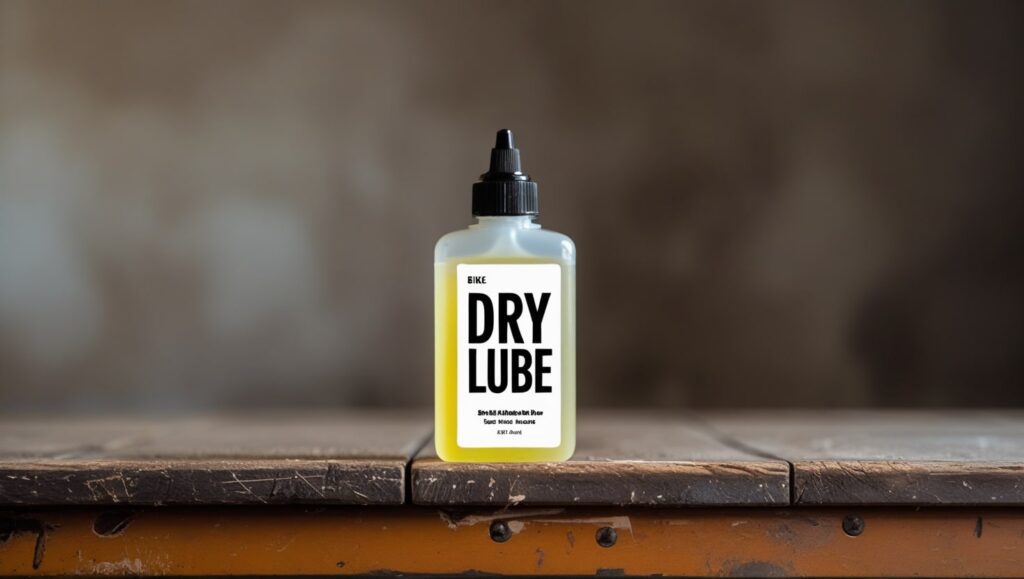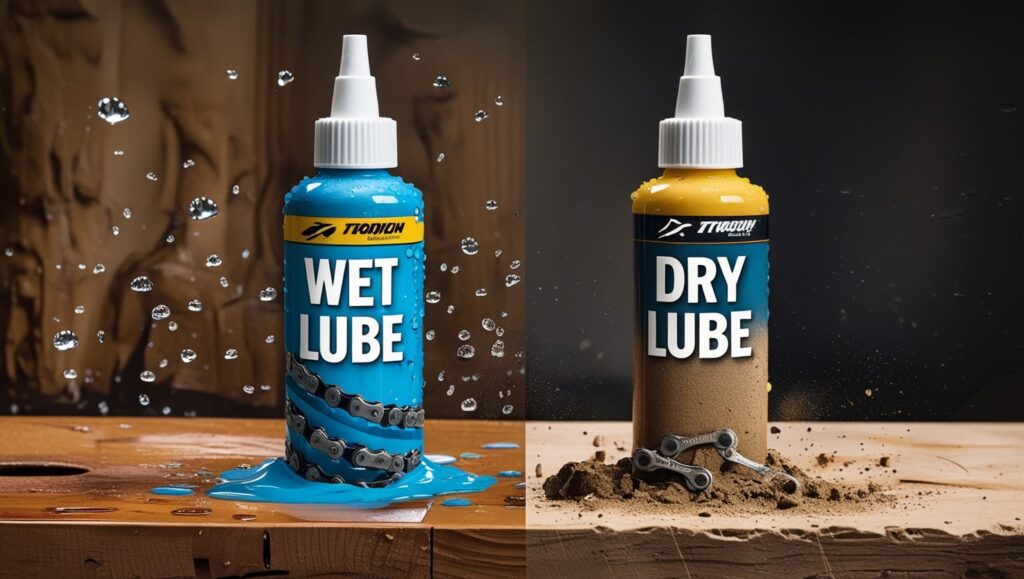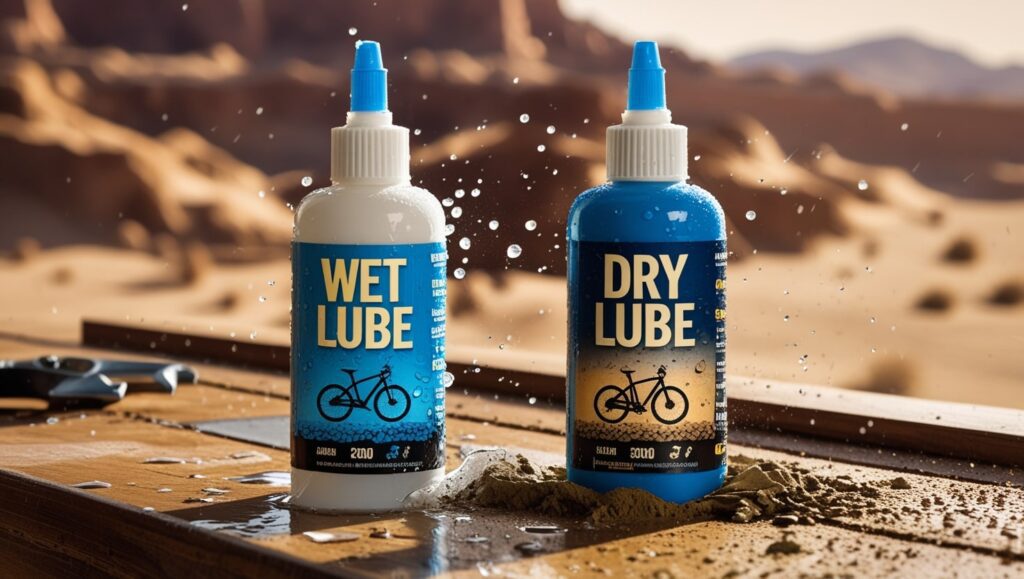After years of riding through both dusty trails and rainy roads, one thing I’ve learned is that picking the right chain lube is more than just a routine—it’s about understanding your conditions. The debate around wet vs dry chain lube comes up often, especially among new cyclists. It’s common to hear that dry lube is ideal for arid, dusty routes, while wet lube handles rainy or muddy tracks better.
But many forget that if you apply the wrong one, you can end up with a messy drivetrain, unnecessary wear, or even damage. That’s why it’s good practice to not just go by weather, but also make sure your bike is clean, your chain is free from gunk and debris, and everything is ready before your next ride.
From my experience, after a tough session on the trails, I’ll always take time to get the drivetrain fully cleaned, often using a degreaser to break down stubborn grime. Just be cautious around sensitive parts like bearings and the rotor. Once everything’s clean, I typically start by finding the master link on the chain, placing the lube on the bottom area—not the top near the cassette—and then turning the pedal backwards slowly. This helps coat each individual roller, ensuring an even rotation and a full application.
Related: How to Remove Rust from Bike Chain
WHAT IS DRY LUBE

From my years riding through dusty paths, I’ve learned that dry lube is a go-to for riding in loose, gritty terrain. When you’re out there and the chain is right in the crosshairs of all that kicked-up dust, dirt, and debris, dry lube protects it by not allowing particles to stick. Once applied, the solvent in the lube will evaporate, leaving a clean coating that doesn’t collect grime.
But there’s a trade-off. In wet conditions, dry lube doesn’t hold up—it’ll wash off quickly when you ride through puddles or rain. That can result in a creaky, noisy drivetrain, causing parts to wear prematurely. Without proper lubrication, the chain isn’t well lubricated, leading to performance issues.
WHAT IS WET LUBE

When I ride through long rainy stretches or damp trails, wet lube becomes a must-have. It’s made to stay on the chain, even when riding through rain or mud. Unlike dry lube, which can get washed away, wet lube lubricates more properly and helps reduce noise from the drivetrain.
It’s much quieter, especially when it’s wet instead of dry. But the downside is that it can attract dust, dirt, and debris, which tend to stick and gum up the drivetrain if you don’t take care of it after applying.
My habit is to wipe away excess lube with a rag once I’m done, leaving just enough to coat the chain. On a slightly drier day, I might still use wet lube over dry, but I’ll let it soak in, then gently remove any leftover residue on the outside links. This little bit of extra attention helps prevent grime buildup and keeps the ride smooth.
Related: Why Is Rust Bad for a Bike?
WHEN TO USE DRY LUBE
One thing I always recommend to a beginner rider is starting out with dry lube—it’s incredibly beginner-friendly and offers easy use. Its chain properties make it perfect for riding on dry and rocky trails, where keeping the chain clean is a little easier. If you’re someone who doesn’t clean or degrease your drivetrain frequently, this type of lube is very forgiving.
However, I’ve learned to avoid dry lube in wet conditions, since that’s one of the main risks. It doesn’t hold up well over extended periods without re-lubing, so if you’re not in the habit of maintaining your chain, it may not perform as expected.
WHEN TO USE WET LUBE
There are plenty of instances where wet lube outperforms dry lube, especially if you’re riding through wet, muddy, or high-humidity conditions. Unlike dry lube, wet lube is made to handle winter, rain, and even protect your chain from salt, which can cause long-term havoc on your drivetrain.
From personal experience, I’ve found it especially useful when I needed to silence a noisy bike or ensure smooth lubrication over long, slushy rides. As an all-season chain lube, it’s recommended for riders who face rough weather more often than not.
That said, Wet Lube demands a bit more attention. Before applying, always review your preferences and make sure you have a proper cleaning and degreasing routine in place.
The Science Behind Wet and Dry Lubricants

Whether you’re into road biking for fun or pushing yourself as a serious cyclist, keeping up with solid bike maintenance is key. Even if you’re just a casual rider, understanding the science behind wet and dry lubricants makes a big difference in how your bike chain performs. These components may seem small, but they’re at the heart of your bike’s performance, helping reduce friction between all the moving parts that work hard mile after mile.
Wet lubes are usually synthetic, petroleum-based oils made to survive damp conditions. Their higher viscosity gives them a kind of stubborn resilience—they won’t easily wash off, thanks to their water-repelling nature. That’s why I always use them in rainy weather or after muddy rides. These lubes prevent moisture from penetrating and harming the duck’s feathers, just like in nature.
Conversely, dry lubes are typically solvent-suspended and wax-based. After application, the solvent evaporates, leaving a thin film that’s great for reducing friction without collecting gunk. I’ve seen the difference firsthand on desert trails and dusty conditions—the chain stays cleaner, and less dust and dirt builds up. The formula might look light, but it holds up well when used right.
Advantages and Disadvantages of Wet Lubricants
Pros of Using Wet Lubricants
Water Resistance: One of the biggest advantages of using wet lube is its excellent water resistance. It’s made to stick to the chain, making it resistant to water, even in heavy rain or unexpected showers. This greatly improves performance in wet conditions where dry lube would easily wash away.
Longevity: From years of cycling, I’ve noticed wet lube lasts much longer between applications compared to the dry variety. It cuts down on maintenance and saves time, which every enthusiast truly appreciates.
Reduced Wear and Tear: Wet lube is thicker and forms a strong protective layer between the metal components of your bike. This helps reduce friction, effectively decreasing wear and tear, keeping your drivetrain running smoother for longer.
Cons of Using Wet Lubricants
Dirt Attraction: One downside of wet lubes is their tendency toward dirt attraction. Their sticky property, which helps with water resistance, also pulls in dust and dirt. This mixture can turn into a rough grinding paste that increases wear on your chain if not removed.
Frequent Cleaning: Because of this buildup, you’ll need frequent cleaning and more regular maintenance. If you’re like me and ride often, it can feel like a bit of a catch-22 — the better the lube clings, the more cleaning it demands.
Necessary Cleaning Prior to Reapplication: Before reapplying, it’s necessary to do proper cleaning to get rid of any residual lube or leftover buildup. As a cyclist, I’ll admit that when I’m rushing, this step can feel like a real chore—but it’s still crucial to avoid further abrasiveness to the drivetrain.
Advantages and Disadvantages of Dry Lubricants
Advantages of Dry Lubricants
Dry lube functions best in dry environments because its tiny particles keep dust and grime from adhering to the chain, keeping it cleaner for longer.
It also reduces build-up of grime, allowing for less frequent bike maintenance—something I personally appreciate on long summer rides when I don’t want to constantly reapply lube.
One major plus is how well dry lube penetrates the inner components of the chain, offering efficient lubrication and reducing friction between chain links, helping everything move smoothly.
Disadvantages of Dry Lubricants
One downside of dry lube is the high frequency of application. It needs to be applied more often, even after short rides, which can feel bothersome if you’re hitting the trails daily.
If you get caught in unexpected rain or a quick shower, dry lubes can become a disadvantage as they’re prone to washing off, leaving your chain exposed and squeaking in no time.
Once washed off, your bike is no longer properly lubricated, putting it at higher risk of wear and tear, especially if not reapplied immediately.
Factors to Consider When Choosing Between Wet and Dry Lubricants

I’ve learned from my riding adventures that choosing the best chain lubricant is not an easy task. It entails assessing a number of crucial elements, such as the riding style, the chain you’re using, and the temperature you ride in. Allow me to explain the lessons I’ve discovered via experience.
Environmental Conditions
When choosing between wet and dry lubricants, the first thing to think about is your environment. If you’re cycling in dry, dusty conditions, dry lubricants are a solid pick—they attract less dirt and are less likely to form a grimy paste with dust, which helps extend your bike’s longevity. But when you’re riding through muddy terrains or caught in unexpected raindrops, wet lubricants are much better. They resist washing off and stay effective even when the trails get messy.
Riding Style
Your riding style plays a big role too. Are you an aggressive rider pushing your endurance, or someone who enjoys a casual, relaxed pace? The more strain you put on your chain, the more your style will impact your lubricant choice. As one of those high-performing cyclists who often takes on long distances at high intensity, I rely on wet lube for its friction reduction and lasting power. However, dry lube might provide sufficient protection without requiring regular reapplication if you ride slowly.
Type of Chain
The type of chain you use also matters. Modern road bike chains are built to work best with specific lubricants, so it’s smart to check your chain’s specifications before picking a lube. Ignoring this detail can lead to performance issues or even damage to your drivetrain.
It takes both knowledge and careful thought to navigate the confusing array of lubrication options. However, you may select a lubricant that genuinely improves your bike performance if you take the proper approach and pay close attention to details. After all, selecting the proper chain lubricant is the first step in any fantastic ride.
Conclusion
Choosing between wet and dry lubrication for your road bike comes down to your specific biking needs and the environment you usually ride in. Understanding the unique properties and differences between these two types of lubes helps you make an informed decision—one that not only improves your ride but also extends the life of your bike. From my own experience, staying consistent with maintaining your drivetrain and matching your lube choice to the conditions makes a big difference in performance and reliability.
Related: What Is a Derailleur on a Bike?
Frequently Asked Questions about Wet vs Dry Chain Lube
1. How often should I lubricate my bike chain?
The frequency with which you should lubricate your chain depends mostly on your riding conditions and the type of lube you’re using. Although it can vary, it’s generally advised to reapply every 100 to 200 miles. Wet lube generally needs less frequent application, so you can go a bit longer between sessions. In contrast, dry lube tends to need more regular attention, especially in dusty or dry environments.
2. Can I use any kind of oil to lubricate my bike chain?
Using all-purpose oil from your workshop might seem like a quick fix, but it’s not a smart choice for your bike chain. Specialized bike lubes are scientifically designed to match the exact mechanics of a bicycle drivetrain, offering better performance and improved longevity.
3. Can wet lube be used in dry conditions and vice versa?
While it’s technically possible to use wet lube in dry conditions or dry lube in wet conditions, I wouldn’t recommend it based on their specific properties. Wet lube tends to attract dirt and grime when used on dry trails, which can turn your chain into a sticky mess. On the other hand, dry lube simply won’t hold up in rain—it will wash away, leaving your chain unprotected.
4. Are there any alternatives to wet and dry lubes?
Yes, there are alternatives to wet and dry lubes, with wax-based options being one of the more popular ones. However, unless you’re really experienced with bike maintenance, I’d still recommend sticking to the basics. Wet and dry lubes remain the most versatile and user-friendly, especially for everyday riders who want simple and effective solutions without extra fuss.
5. Can I mix wet and dry lube?
From experience, I strongly advise against mixing different lubes. Doing so can cause inconsistency in application, which may result in poor performance or even long-term damage to your drivetrain. It’s best to stick with one type of lube at a time. If you do decide to switch between lubricant types, make sure to clean your chain thoroughly before switching, so the new lube can work as intended without interference.








